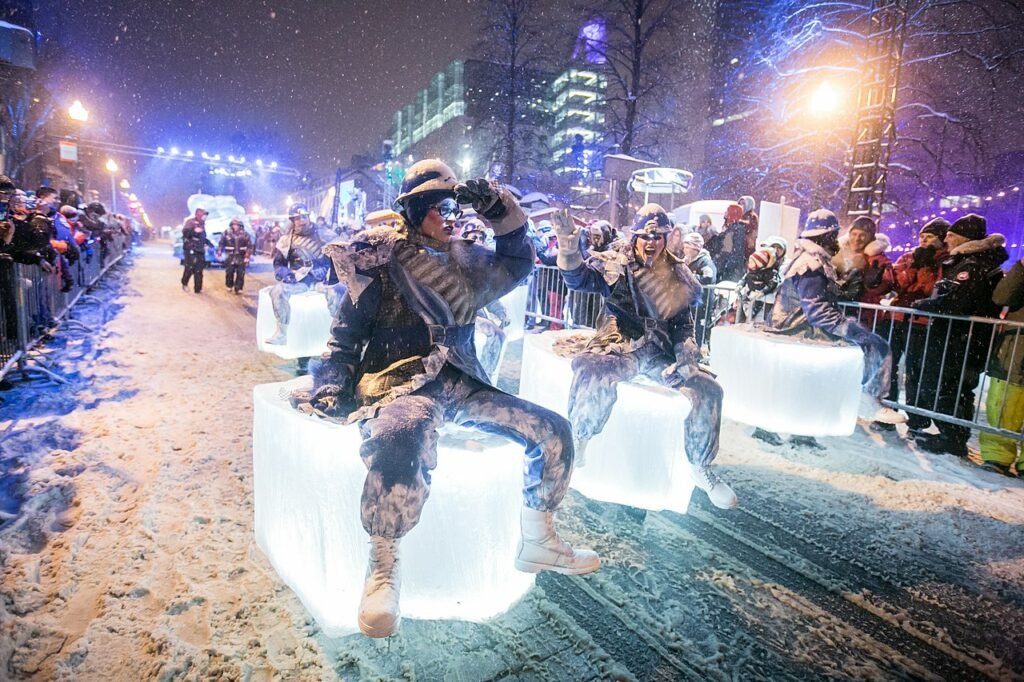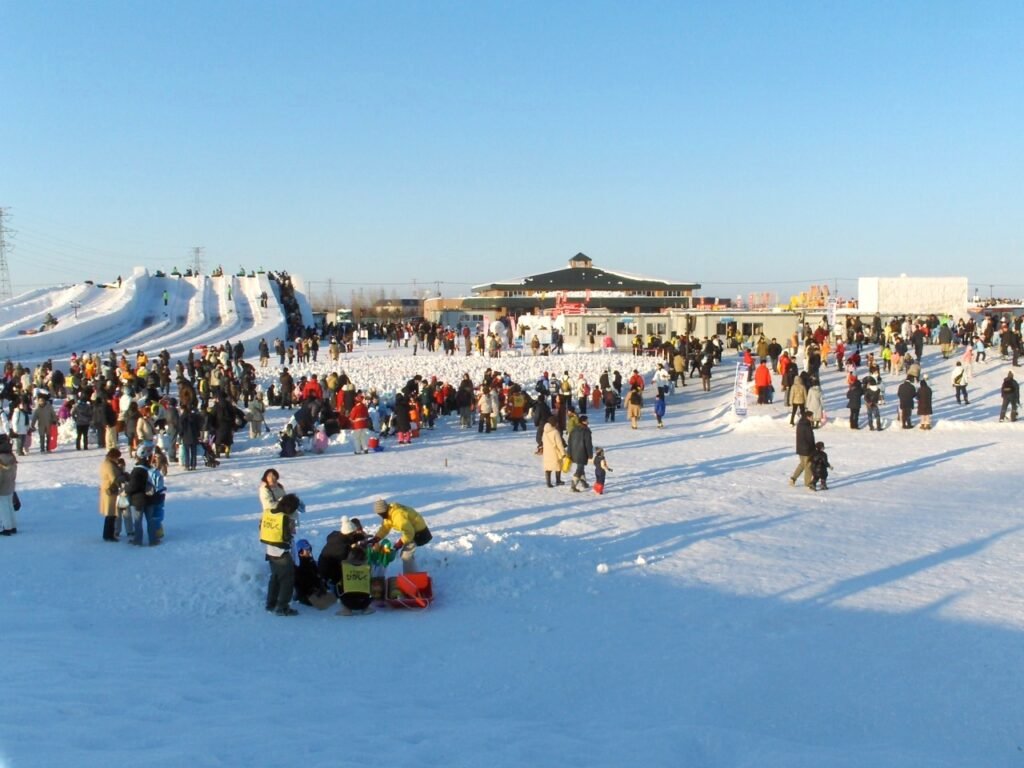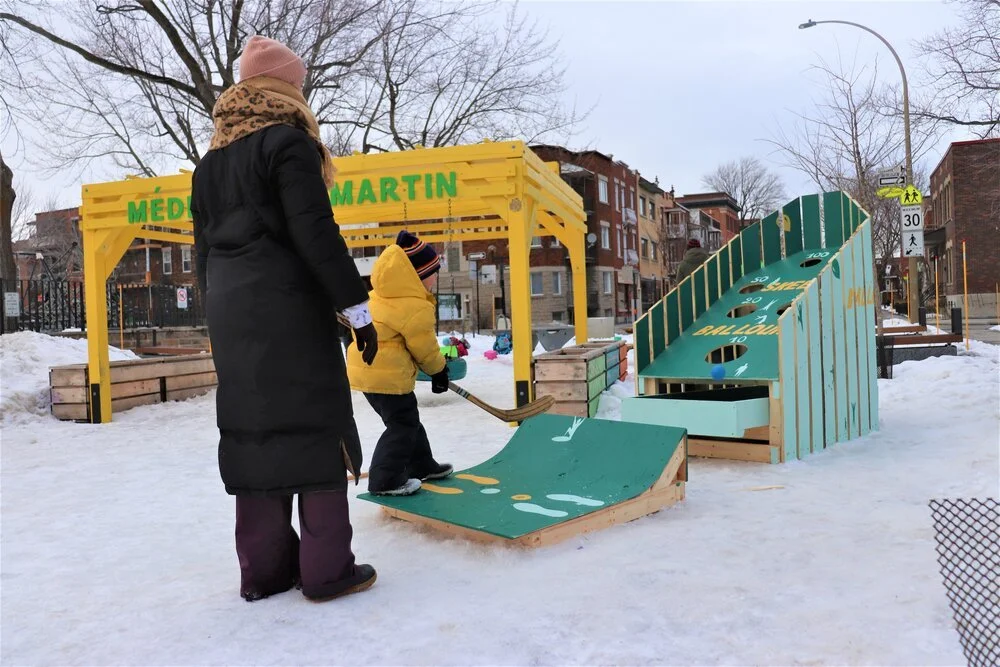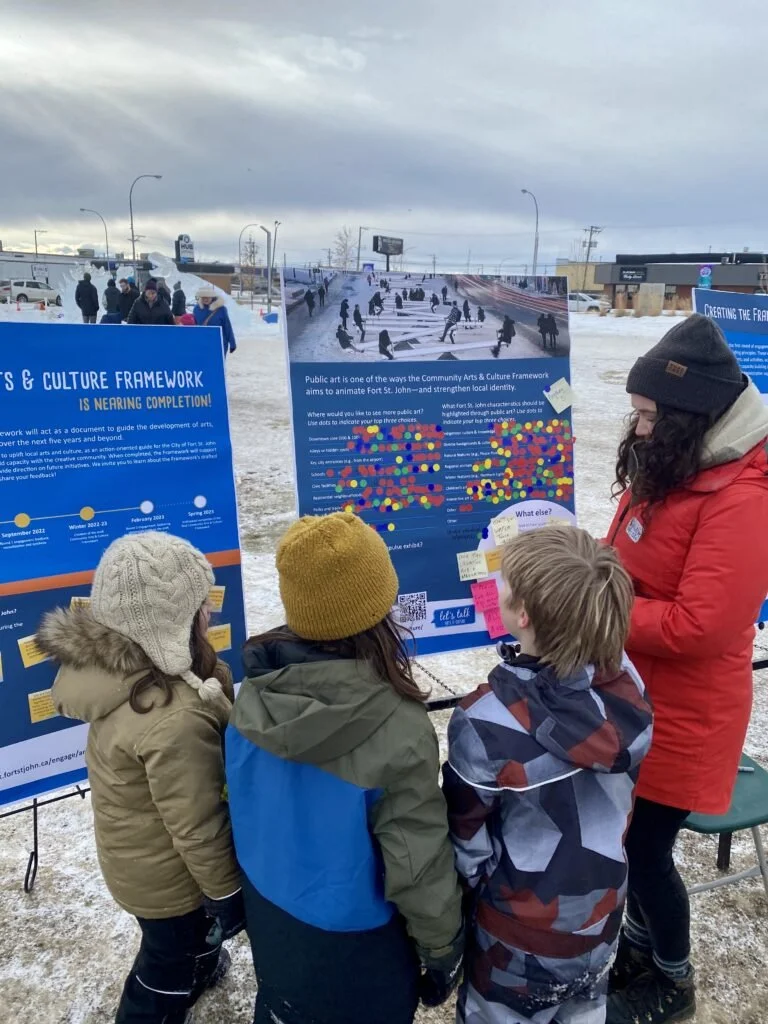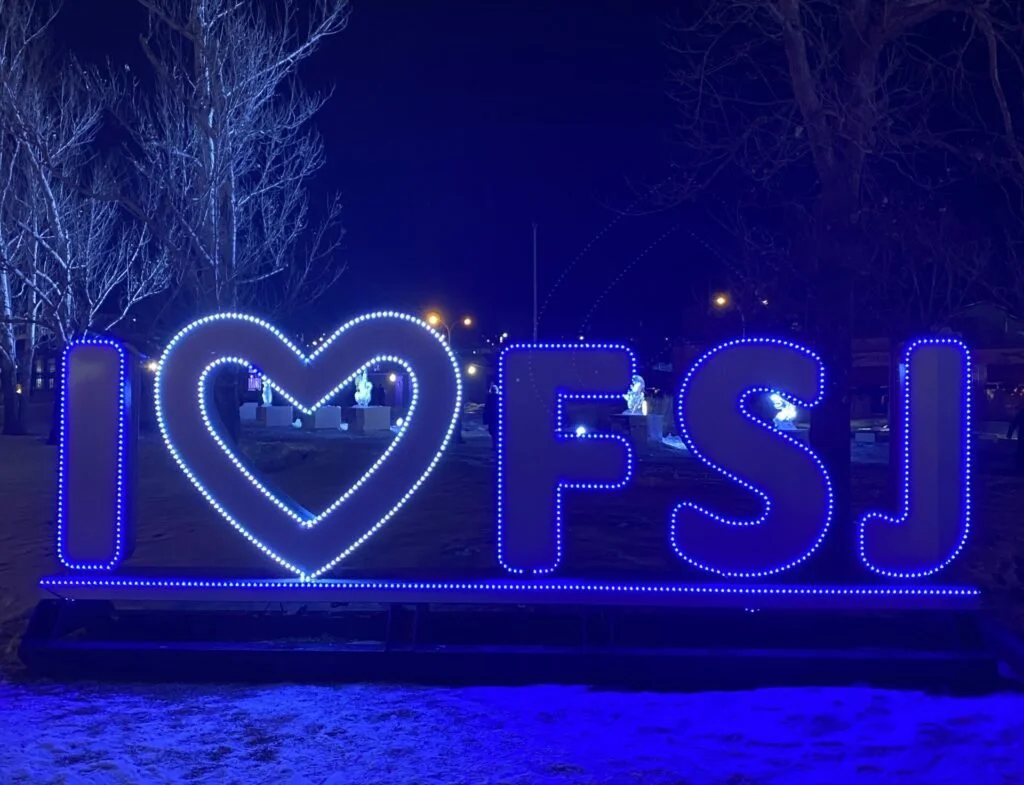High on ice: Winter placemaking in a northern city
Local residents gather to share thoughts on arts and culture in Fort St. John, at the High on Ice winter festival. (Mitchell Reardon / Happy Cities)
By Emma Avery, Leah Karlberg, and Mitchell Reardon
Winters in Fort St. John are cold and dark. On the shortest days of the year, the sun rises around 9:30 a.m. and sets at 4:30 p.m., while low temperatures average near -20 degrees Celsius.
So what brought our team to Fort St. John in the middle of winter? We travelled in February for the city's High on Ice festival, an annual winter event that draws people from across region to see ice sculpture carving, live music, ice slides, a homemade snowshoe race, and more. Officially, we were there to hear input from local residents on a new Community Arts and Culture Framework that our team is working with the City to develop. Opportunistically, we jumped at the chance to see Fort St. John’s unique winter placemaking activities in action.
Fort St. John is a small city of just over 21,000 residents, and a 14-hour drive northeast from Vancouver. The city serves as a hub for the Peace Region, an area consisting of seven municipalities in northern B.C. near the Alberta border. Although Fort St. John was recently named the most affordable small city in BC, City staff and local residents shared that it can be difficult to build a sense of community there. In this context, arts, culture, and community events are vital for boosting social connection and community wellbeing, and attracting residents and visitors—year-round.
Turning winter challenges into opportunities
The dark and cold pose challenges for maintaining social connection, but life doesn’t stop in the winter. Instead, winter cities get creative to figure out how to draw people together year-round. This includes making use of outdoor spaces, even in the cold. Placemaking—in the form of art, cultural activities, furniture, lighting, and other creative design elements—is a key strategy for bringing shared spaces to life in winter, encouraging people to get outside and stay connected, and helping to reduce social isolation.
Carnaval de Québec, Canada. (Stagiairec / Wikimedia Commons)
Carnaval de Québec, Canada. (Jamie McCaffrey / Flickr)
Sapporo Snow Festival, Japan. (Daigaku2051 / Wikimedia Commons)
Sapporo Snow Festival, Japan. (David McKelvey / Flickr)
Winter placemaking at a park in Montréal, Canada. (Charles-Olivier Bourque / La Pépinière Espaces Collectifs)
Rideau Canal, Ottawa, Canada. (Lezumbalaberenjena / Flickr)
The most successful examples of placemaking build on what is unique to a city or community, and invite everyone to participate. Through thoughtful planning and design, cities can turn winter challenges into opportunities: Cities can creatively use elements of a harsh climate to their advantage to foster pride and joy, using lights, snow, and ice to highlight the magic of winter places.
“High on Ice celebrates an artistic medium that is reflected in our local landscape,” said Eryn Griffith, Arts and Culture Manager for the City of Fort St. John. “We can’t have ice slides or sculptures without a northern climate.”
Ice sculptures and slides at Fort St. John's High on Ice winter festival. (Leah Karlberg / Happy Cities)
Drawing people outside in a small, northern city
Many people move to northern B.C. for seasonal work—bringing economic activity to cities like Fort St. John, but posing challenges for creating a sense of community and place. More broadly, smaller towns and northern cities often experience a high turnover of residents, struggling to retain young people, teachers, and health care professionals, for example.
Placemaking is essential for making the city a place that people want to stay and establish ties in. By bringing diverse residents together, it has the power to boost social connection. As of 2021, nearly one third of Fort St. John’s residents had moved to the region within the last five years—17 per cent of whom were also new to Canada. Combined with seasonal workers, these numbers mean there is a large body of people who may not have a lot of strong connections to or within the city—or may have never experienced a winter climate before.
"Most people come up here to work,” explained one local resident we met. “The community activities are really cool and the free stuff is very important—things like High on Ice and the concerts at the park in the summer."
The City of Fort St. John has been tackling these challenges through strategic planning, including its Winter City Micro-Project Strategy, introduced in 2017. The strategy includes projects such as winter-themed parks, a winter walks to school program, community fire pits to create warm outdoor gathering spaces, and a winter arrival package for newcomers—complete with toques and a winter tips guide.
Since 2022, our team has been working with the City to explore how arts and culture can contribute to a vibrant, diverse city that promotes a unique sense of place and community, through the creation of the City’s first-ever Community Arts and Culture Framework. A key focus of the framework is to support an inclusive arts and culture community that everyone can participate in. Through this work, the City aims to boost quality of life, support reconciliation, cement a unique sense of identity for Fort St. John, and strengthen the local economy.
“Fort St. John has a vibrant collective of arts’ guilds, such as our potters, printmakers, spinners and weavers, and quilters,” said Griffith. “We embrace our local performers through many forms of music, such as our local Indigenous drummers and independent musicians.”
Talking to local residents about arts and culture in Fort St. John. (Leah Karlberg and Mitchell Reardon / Happy Cities)
Creative placemaking for wellbeing and social connection
Cities small and large show that seasonal arts, culture, and placemaking are more than just nice-to-haves. They’re essential ingredients for creating a great place that people feel a sense of attachment and belonging to, and key strategies for supporting social connection, vibrancy, and community resilience. Although Fort St. John is one of the smallest municipalities in B.C. to create an arts and culture department, the community offers an example of how, even in a small city and northern context, placemaking can support wellbeing—year-round.
“I’ve come here to High on Ice quite a few times,” one resident told us. “I really like the ice sculpting. It’s cool to come out, with the fire and the slide hill for kids, and to see what local artists can do.”
In turn, by offering people opportunities to have fun and connect with their creative selves, cities can help boost wellbeing. When people have positive memories of a place—such as an event or festival—they are more likely to feel attached to that place. These feelings then increase the likelihood of people returning for work and play, supporting both economic activity and social connection. In Fort St. John, creative placemaking initiatives like High on Ice can help to retain residents for the long term, and help newcomers to grow roots and feel at home in a northern climate.
People play on glowing see-saws at Impulse, an interactive public art installation in Fort St. John this winter. (Mitchell Reardon and Leah Karlberg / Happy Cities)
“The High on Ice Winter Festival, a temporary interactive art installation [called Impulse] in a vacant lot, and new outdoor skating rinks are just a few of the recent initiatives of how we are embracing winter in our community,” said Fort St. John Mayor Lilia Hansen. “By creating these spaces and events, we also reap the health benefits of improving our physical, mental, and social selves.”
Recognizing the importance of community activities and artistic opportunities for wellbeing, Fort St. John tries to ensure that many arts and culture events and services are free, so that as many residents as possible can enjoy them.
“Arts and culture activities help people to connect with one another and embrace northern living in many ways,” said Griffith. “Whether it’s interactive art installations, outdoor festivals, unique partnerships, or neighbourhood grant programs throughout the year, these activities all promote a lively and encouraging space for our community and local region to embrace northern living.”
To learn more about this work, visit the project page or contact us.
Public art pieces can help establish a sense of place. (Mitchell Reardon / Happy Cities)


